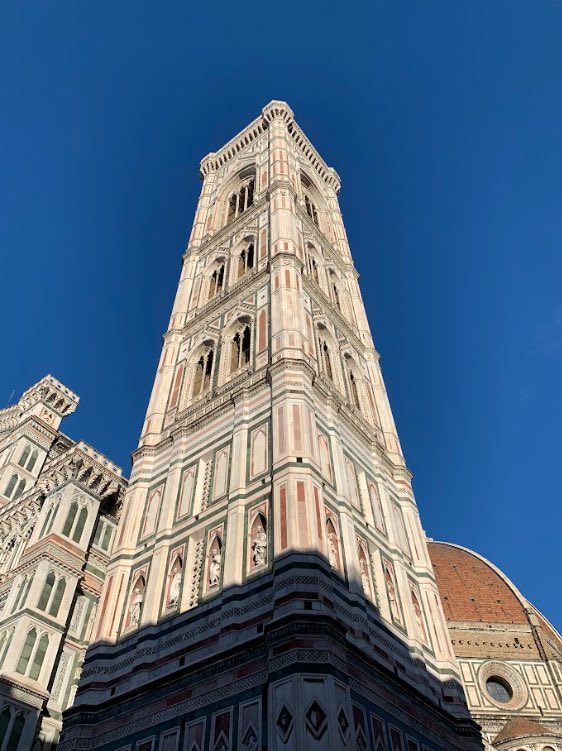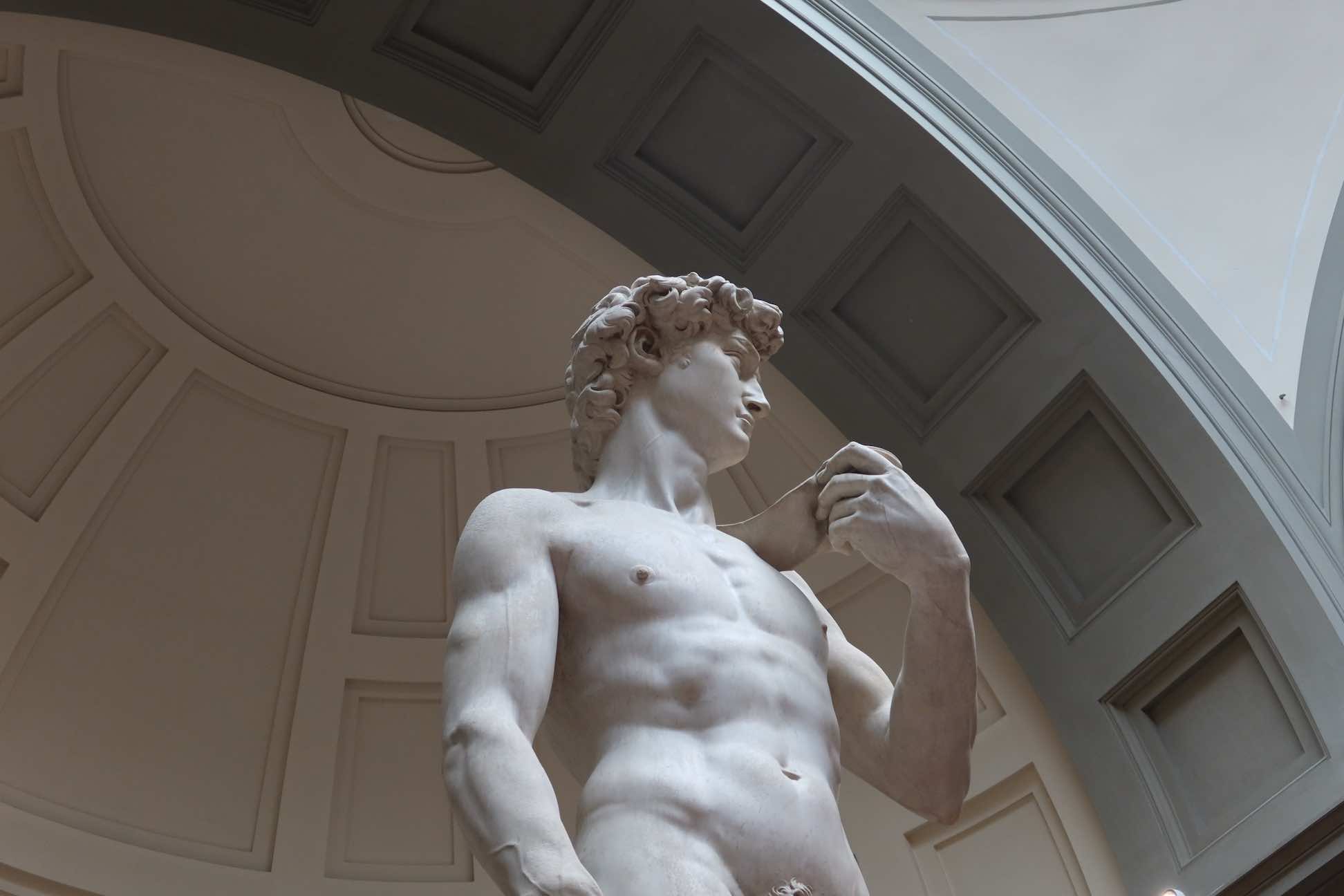- Sign up & get a FREE ebook Subscribe Today!
- Florencewise Home Page
- What to do in florence
- Florence Bell Tower
Florence Bell Tower - How to visit Giotto's Bell Tower
The Florence bell tower is one of the most iconic landmarks in Italy and part of the monumental complex of Florence's Duomo.
Giotto's bell tower undoubtedly rules the city skyline.
Find out how you can visit this stunning part of the Duomo complex and why it's worth visiting!
Florence Bell Tower - Everything you need to know
Next to the cathedral of Florence in Piazza del Duomo, Giotto's Campanile is simply breathtaking.
Part of the central Duomo complex, the bell tower reaches up high into the sky, and if you are able to climb the 414 steps to the rooftop terrace, you'll be rewarded with incredible views of Florence.
Keep reading to find out everything you need to know about Giotto's bell tower, including:
- What is Florence's Duomo complex?
- A brief history of the Florence bell tower
- The architecture of Giotto's bell tower
- Special things to see on the bell tower
- Climbing Giotto's bell tower
- Opening hours and ticket information
Florence's Duomo complex
Like other cities in northern Italy and Rome at the end of the Middle Ages, their increased wealth inspired the Florentines to expand their religious centre.
In 1296, work started on the new cathedral on the site of the ancient church of Santa Reparata.
The idea was to create a grand complex worthy of Florence's status. Here, almost two centuries before the time we speak of, a Baptistery was built (now the oldest building in the city) but it would take over two hundred years to finish the majestic cathedral and elegant but sturdy bell tower.
These sacred buildings were at the heart of the medieval city and have remained so ever since.
If you're ever lost in Florence, simply look up and find the iconic red brick dome!
A brief history of the Florence bell tower
After the original architect of the cathedral Arnolfo di Cambio died, the project was given to the famous Florentine master Giotto di Bondone to complete.
As part of his updated plans for the cathedral of Santa Maria del Fiore, Giotto designed an elegant bell tower to stand alongside it.
Who was Giotto?
Giotto was arguably one of the most important painters in Western art history, almost single-handedly changing its course.
His artistic creations marked the beginning of a new era in painting, blending religious antiquity with the emerging concept of Renaissance Humanism.
Giotto's notable achievements lie in his exploration of perspective and the depiction of pictorial space, which introduced a fresh sense of authenticity to his religious allegories.
Giotto as an architect
Giotto's architectural achievements were also praised widely.
It was the construction of the sky-scraping Gothic bell tower (a structure renowned for its ornamental and functional design) next to the cathedral, that did so.
Giotto's campanile is widely regarded as the most exquisite in all of Italy.
Building the Bell Tower
While the initial stages of construction began during Giotto's lifetime, he died in 1337 and his apprentice Andrea Pisano took over the work.
Andrea Pisano followed Giotto's plans for the bell tower construction and continued to build up the levels of the tower until the Black Plague interrupted work in 1348.
The last floors of the bell tower were completed by Francesco Talenti in the 1350's.
Francesco Talenti stuck to Giotto's designs except for the spire at the very top of the tower, omitting this final element in order to make sure the bell tower could be finished without further interruptions!
When the 280ft/85m tall bell tower officially opened in 1359, it was then Florence's tallest building.
Despite the fact he never saw the bell tower completed, the building has been associated with Giotto's name ever since.
The architecture of Giotto's bell tower
The Florence Cathedral bell tower is a key feature of the Duomo complex (made up of Giotto's Campanile, the Cathedral of Santa Maria dell Fiore with the ancient church of Santa Reparata underneath, and the Baptistery).
It matches the high level of intricacy of the other buildings.
The tower that came to transform the entire city’s decor is very much Giotto's vision, even though he died when only the lower floor was completed.
His ability to match colors and geometry within the architectural design was the key to the uniqueness of the project.
The bell tower architecture
The five storeys of the tower were built at different stages, the first level by Giotto himself and then the second by Andrea Pisano after Giotto's death.
Pisano also died before the final three levels were built, with Francesco Talenti completing these stories.
The only change from Giotto's original design was the very top, where he had envisioned a tall spire.
Francesco Talenti instead built a large projecting terrace, from which you have incredible views of Florence and out to the surrounding hills of Tuscany.
Florence's Duomo Complex
Want to know more about the fascinating history of Florence's cathedral, the iconic dome and more?
This book sets out the engaging story of how the architectural masterpiece came to be.
Disclosure : If you make a purchase through a link on this page, I may receive a small commission - at no extra cost to you. Thank you for supporting my site!
The exterior architecture
Giotto himself meticulously took care of the selection and purchase of precious marbles such as the white Carrara marble, the green colored marble of the Prato quarries and the rarest Maremma red marble stones.
He thought to give the Campanile a sturdy shape, a regular quadrilateral with sculptural charts inserted on the sides.
The facade consists of perfectly aligned horizontal layers with green marble inlay.
Hexagonal panels, bas-reliefs and coloured stripes alternate all the way to the top.
White marble ridges frame the different stories and the tower and the corners of the tower are also accentuated, becoming an iconic representation of the Florentine Gothic architecture style.
Special things to see on the bell tower
With the construction of the tower lasting longer than the lives of two out of three of the architects working on it, we can see time passing by in the several layers.
The tower is adorned with sculpted decorations by different artists, all depicting various subjects.
Stylized geometric patterns in red and green marble work their way up the tower along with relief carvings and various sculptures.
Starting from the bottom and moving upwards, here are the different layers and their corresponding artists and subjects.
The themes on display were thought to describe the progress of mankind, with a daring narrative, valuing his work, the arts and sciences.
The reliefs and statues on the bell tower
The lower level of the bell tower on its square base features hexagonal marble panels with reliefs.
These relief carvings narrate scenes from the book of Genesis.
The original hexagonal panels by Andrea Pisano were removed in the 1960's to preserve them, and are now on display in the Museo dell'Opera del Duomo.
The next layer has diamond shape tiles with white marble figures against a blue majolica background.
The figures come with certainty from Pisano's workshop and show the Planetes, the Virtues, the Arts and the seven Holy Sacraments.
As for all these sculptures on the facade today, they are also very carefully made copies.
On the third row, looking out over the square from their various niches, you might spot Sybills, Prophets, and Patriarchs.
In total, there are 16 life-size statues, all works of several artists including Andrea Pisano, Donatello, and Luca Della Robbia.
Gothic decorations
The decorations of Giotto's bell tower are elaborate, and accentuate the architecture of the tower.
Built in the 13th century, the Campanile is a prime example of late-medieval Tuscan architecture.
Looking up, you'll notice pointed arches, but the Gothic elements are tempered by local traditions.
It is interesting to keep in mind that the sculptures on the bell tower were made within decades of each other, during a time when art was evolving rapidly, so all these sculptures are slightly different styles.
Towards the top of the tower
The top three levels were designed by Francesco Talenti.
Each of the top three storeys is larger than the one below, but in such a way that the different sizes perfectly counters the effect of perspective.
When looking at the bell tower from the street, each level looks exactly the same size because of this clever architecture!
 The very top of the tower is different to Giotto's original design but makes for an ideal viewing platform
The very top of the tower is different to Giotto's original design but makes for an ideal viewing platformTalenti used vertical windows with gothic pointed arches to open up the facade.
Where Giotto had envisioned an elegant spire, he crowned the tower with a projecting terrace instead to get it finished.
🤙 Roaming in Italy? 📱
Get yourself an Italian eSIM for calls, messages and data when traveling here.
Save on data charges with plans from just 19€ from Holafly - our recommended eSIM provider - click here to find out more.
The seven bells
Giotto's Campanile has seven active bells.
The largest bell is called Santa Reparata, a reminder of the saint whose church originally stood where Duomo does now.
Because of its extraordinary size, this bell is also often referred to as the Campanone (big bell).
Campanone's companions and musical partners all have names related to the Virgin Mary and are called Misericordia, Assunta, Apostolica, Mater Dei, Annunziata and Immacolata.
 I loved seeing the details on these bells, even though they were not designed to be seen, only heard!
I loved seeing the details on these bells, even though they were not designed to be seen, only heard!Climbing Giotto's bell tower
Why climbing Giotto's bell tower should be on your list
Brunelleschi's impressive dome might be the more obvious choice to climb, but did you consider the fact that climbing Giotto's bell tower gives you the best view of that dome?
Plus, you'll be rewarded with an equally spectacular view over the city of Florence.
Want to know more about climbing the bell tower, as well as the other towers in Florence?
Check out our video for all the details you need:

Staircases and levels
It is not the most comfortable climb, as the stairs are quite steep and narrow.
There are several points where you can catch your breath, take a break, and admire the surroundings.
But despite the challenge, climbing to the top of Giotto's tower, taking on all the uncomfortable steps (414 to be precise and there is no elevator) is an amazing experience.
Once at the highest point, your efforts will be rewarded with an amazing view of the glorious city center as well as unique glimpses of the suburban area and the hills beyond.
Take a look at these pages to find out how to make the most of your time in Florence:
Florence Bell Tower opening hours and ticket information
As with most major sites, it is always best to order your tickets in advance, online.
To climb the tower you'll either need a Brunelleschi Pass or a Giotto Pass that you can purchase on the website of the Opera dell'Duomo.
Here you can (and must) also book your time slot.
 Even when you book there will likely be a queue as they regulate the number of people inside the staircases for safety
Even when you book there will likely be a queue as they regulate the number of people inside the staircases for safetyGiotto's Campanile is located on Piazza del Duomo.
Opening hours of the tower are 08:15 AM - 18:45 PM and the entrance is at the back of the tower.
Large bags, bulky backpacks and other luggage must be stored in the cloakroom next to the Museo dell'Opera del Duomo (behind the Cathedral).
If you’ve been wondering whether the Campanile di Giotto deserves your attention, don’t think it over.
Climb up and you’ll see!
Florencewise's Top Travel Resources
Ready to book your trip to Florence? Take a look at these helpful links to companies we use and trust:
- Keep your travel spending simple with the Wise card, which removes all the worry about exchange rates and high transaction fees all over the world
- Search for and book your perfect accommodation
- Our complete guide to what to pack for Florence
- The number one travel accessory, a multi-point travel adapter and voltage converter
- Browse a huge range of tours in Florence and beyond
- Experience unique tours and special access to Florence's most popular sights
- Protect yourself with comprehensive travel insurance
Within this post there are some affiliate links for products and services. For more details about our affiliate policy click here.
Receive the latest Florence news, travel tips, insights and more!
Simply sign-up today for our free newsletter:
We are committed to respecting your data. Click for our Privacy Policy.
Comments? Questions? Suggestions?
Please come over to the private Facebook group and join in the conversation.
You will often find me there, happy to answer your questions / comments!
You will also meet other Florence lovers and experts, too.
What are you waiting for?

























